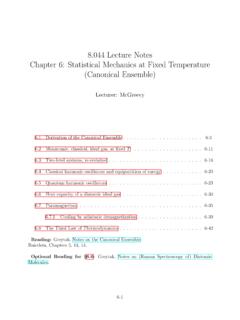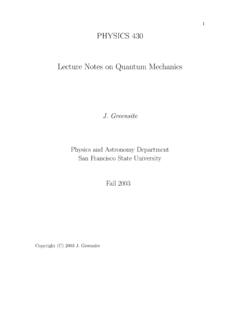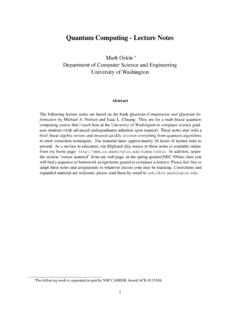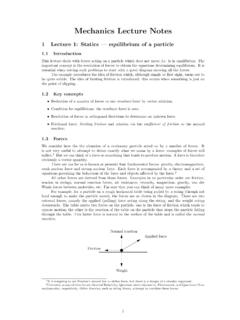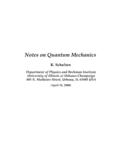Transcription of 8.044 Lecture Notes Chapter 9: Quantum Ideal Gases
1 Lecture Notes Chapter 9: Quantum Ideal Gases Lecturer: McGreevy Range of validity of classical Ideal gas .. 9-2. Quantum systems with many indistinguishable particles .. 9-4. Statistical mechanics of N non-interacting (indistinguishable) bosons or fermions 9-9. Classical Ideal gas limit of Quantum Ideal gas .. 9-13. Ultra-high temperature (kB T mc2 and kB T ) limit .. 9-15. Fermions at low temperatures .. 9-18. Bosons at low temperatures .. 9-33. Reading: Baierlein, Chapters 8 and 9. 9-1. Range of validity of classical Ideal gas For a classical Ideal gas, we derived the partition function 3/2.
2 Z1N.. V 2 mkB T. Z= , Z1 = 3 = V , N! th h2. h where the length scale th 2 mkB T. is determined by the particle mass and the temperature. When does this break down? 1. If idealness' fails, if interactions become important. This is interesting and impor- tant but out of bounds for We'll still assume non-interacting particles. 2. If classicalness' fails. Even with no interactions, at low enough temperatures, or high enough densities, Quantum effects modify Z. An argument that classicalness must fail comes by thinking harder about th , the thermal de Broglie wavelength . Why is it called that?
3 Recall from that the de Broglie wavelength for a particle with momentum p is dB = hp . For a classical Ideal gas, we know the RMS. momentum from equipartition p~2 3 p p h i = kB T = pRMS h~p2 i = 3mkB T . 2m 2. We could have defined h h th = ;. pRMS 3mkB T. there's no significance to the numerical prefactor of 1 instead of 1 . 2 3. Now recall the significance of dB in QM: h dB = minimum size of a wavepacket with momentum p . p So we can infer that th minimum size of Quantum wavepackets describing atoms in a Quantum Ideal gas . The classical picture of atoms as billiard balls with well-defined trajectories only makes sense if 1/3.
4 V. th typical spacing between particles =. N. V 1/3. And this inequality th 1T N.. is violated at low T or high density. The above inequality is the condition for validity of the classical treatment. 9-2. V 1/3.. System T N. / th conclusion . air 300K 180 classical Liquid 4 He 4K not classical Conduction e in Cu 300 K not classical A second derivation of the same criterion, this time in momentum space: Consider solutions to the Schro dinger equation in an L L L box. The energy eigenstates of one particle are . m ~ (~. x) = sin (kx x) sin (ky y) sin (kz z) with k = m , and m = 1, 2, x L x x y y y z z z with energy eigenvalues ~2.
5 Kx2 + ky2 + kz2.. =. 2m Let's ask under what circumstances we can ignore the QM. The mean energy per particle in a classical Ideal gas is 23 kB T . How many 1-particle states with energies like this are there to put our N particles into? The number of states with 23 kB T is . 1 4 2m 23 kB T 3/2. 1/2. 8 3 ~2 volume of octant of sphere in ~k-space with radius 2mE. ~2. N ( ) = =. ( /L)3 volume in ~k-space per allowed grid point r !3 . mkB T V 3 2. = V 4 3 = 3 . h th . So: when N V3 , the number of particles is big compared to the number of possible one- th particle states for the particles to sit in.
6 So we need to worry about things like the Pauli Exclusion principle, which prevents us from putting more than one particle in each state. For N V3 , the classical analysis is fine we needn't worry about the particles needing to th occupy the same 1-particle state. 9-3. Quantum systems with many indistinguishable particles [This section is about Quantum mechanics . You've already encountered some of these ideas in , and will discuss this further in We'll come back in subsection and think about when this business reduces to classical mechanics .]. Consider two particles. Their state can be described by a wavefunction (x1 , x2 ).
7 (We won't worry right now about how many coordinates of each particle ( how many dimensions). we have to specify.) If the particles are indistinguishable, then | (x1 , x2 )|2 = Prob finding a particle at x1 and a particle at x2.. Note that we make no specification of which particle is where. Indistinguishability requires: | (x1 , x2 )|2 = | (x2 , x1 )|2. Swapping the arguments twice should give back the same , not just the same | |2 : (x1 , x2 ) = (x2 , x1 ). 9-4. Two choices: Bosons particles for which (x1 , x2 ) = + (x2 , x1 ). , the wavefunction is symmetric. It is a fact (observed experimentally, understood via Quantum field theory) that they have integer spin.
8 : hydrogen atoms, 4 He, photons, phonons, magnons, gluons, Higgs bosons (?). The stat mech of a gas of them was developed by Bose and Einstein, so in the context of stat mech, these are called Bose-Einstein statistics . Fermions particles for which (x1 , x2 ) = (x2 , x1 ). , the wavefunction is antisymmetric. It is a fact (observed experimentally, understood via Quantum field theory) that they have half-integer spin (1/2, 3 ). : electron, proton, neutron, 3 He, 7 Li. The stat mech of a gas of them was developed by Fermi and Dirac, hence Fermi-Dirac statistics . For non-interacting Bose or Fermi particles (we will always assume this): energy eigenstates are always (symmetric or antisymmetric) linear combinations of products of single-particle energy eigenstates.
9 [Recall: there is more to QM than energy eigenstates, but they are enough to construct the partition function.]. 9-5. Wavefunctions of several bosons or fermions Consider for example two indistinguishable Quantum particles in a box. Label the possible states of one Quantum particle in the box by a fancy label which is a shorthand for all its Quantum numbers, , the wavenumbers (mx , my , mz ) of its wavefunction. If they are bosons, the wavefunction must be of the form (x1 , x2 ) = (x1 ) (x2 ) +. |{z} (x1 ) (x2 ). | {z } | {z }. an energy eigenstate another energy eigenstate makes it symmetric of one particle for one particle OK state of bosons | {z }.
10 Not sym or antisym hence not allowed For fermions: (x1 , x2 ) = (x1 ) (x2 ) . |{z} (x1 ) (x2 ). makes it antisymmetric OK state of fermions Working our way up to 3 indistinguishable particles: (x1 , x2 , x3 ) = (x1 ) (x2 ) (x3 ) (x1 ) (x2 ) (x3 ). (x1 ) (x2 ) (x3 ) (x1 ) (x2 ) (x3 ). (x1 ) (x2 ) (x3 ) (x1 ) (x2 ) (x3 ). with + for bosons and for fermions. This time we count 1, 2, 3, many: 9-6. N indistinguishable particles: 1. Pick N single particle states , , .. 2. There is exactly one symmetric combination. This is an energy eigenstate for N bosons. 3. IF , , .. are ALL DIFFERENT then there is exactly one antisymmetric combi- nation.
